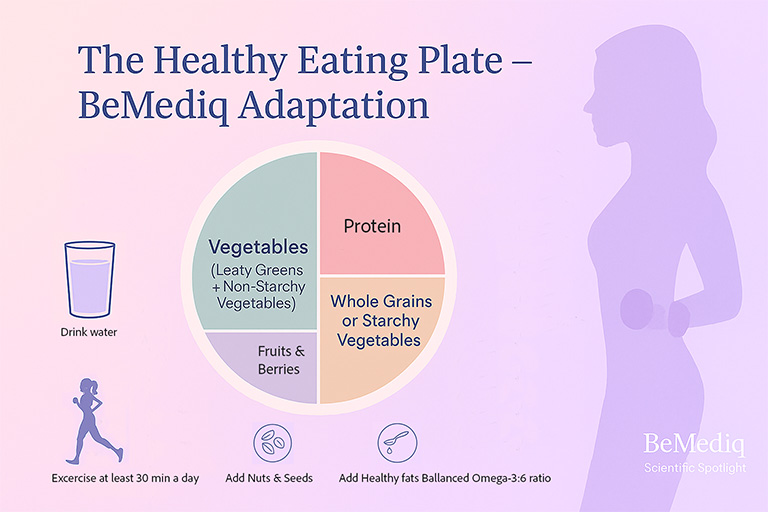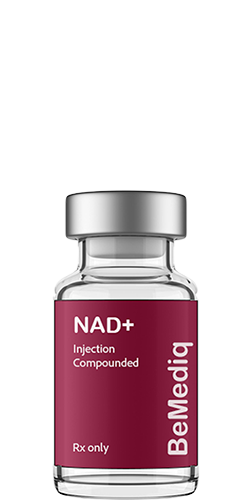Based on the 2024 review “The Importance of Nutrition in Menopause and Perimenopause” published in Nutrients by Erdélyi, Barta & Lugasi. Certain examples have been ethically adapted to align with BeMediq’s environmentally conscious philosophy.

The Invisible Shift: How Nutrition Rewrites the Story of Menopause
It begins quietly.
A few restless nights. A shorter fuse. Clothes that fit differently.
Somewhere between forty and fifty, the rhythm changes — not all at once, but like a tide withdrawing. Beneath the surface, the hormones that once orchestrated everything from metabolism to mood begin to fade, and the body starts composing a new kind of equilibrium.
This transition — menopause — is more than the end of fertility.
It is a metabolic turning point.
What a woman eats, drinks, and practices each day can soften that transition — or accelerate the cascade of changes that follow.
A research team from Semmelweis University and the Hungarian Dietetic Association recently published a review in Nutrients (Erdélyi, Barta& Lugasi, 2024), synthesizing decades of data on how nutrition influences this phase of life.
Their conclusion was clear and empowering:
Nutrition is not an accessory to menopause care — it is central.
Evidence-based dietary strategies, they found, may reduce the risk of cardiovascular disease, insulin resistance, type 2 diabetes, osteoporosis, and hormone-sensitive cancers — while improving quality of life during perimenopause and beyond.
Food, in other words, becomes both prevention and therapy — when it is aligned with the body’s shifting biology.
1. The Hormonal Shift: When Hormones Fall, Metabolism Follows
For many women, the weight gain or body changes that appear in midlife can feel inexplicable. This review helps make sense of them.
Estradiol — the dominant form of estrogen in premenopausal women — does far more than regulate reproductive cycles. It influences appetite, muscle insulin sensitivity, and liver glucose metabolism.
As estradiol declines, basal metabolism slows by roughly 250–300 kcal/day, and appetite regulation weakens. Over time, small shifts accumulate:
- Increased visceral (abdominal) fat
- Reduced lean muscle mass
- Greater oxidative stress and inflammation
- Lower insulin sensitivity and altered lipid profiles
These changes explain why menopause marks a distinct inflection point in women’s health: cardiovascular risk rises, bone density declines, and metabolic resilience weakens.
Practical takeaway:
For women with overweight or increased abdominal fat, even modest weight reduction — around 5 kg — may improve metabolic flexibility and reduce vasomotor symptoms.
(Author’s note: for women with a healthy BMI, the focus should be on preserving lean muscle mass through adequate protein and resistance exercise.)
2. Building a Balanced Diet for Midlife Health
There is no one “menopause diet.” What matters most, the review emphasizes, is an individualized, sustainable way of eating — one that can be lived with and loved, not endured like a temporary fix.
Very low-calorie diets (<1200 kcal/day) may promise quick results but often deplete muscle mass and micronutrient stores. Instead, a moderate, tailored approach works best: reduce energy intake by about 500–700 kcal below current needs — never below Basal Metabolic Rate — aiming for gradual fat loss while preserving lean tissue.
BeMediq author’s note: Basal Metabolic Rate — or BMR — represents the calories your body needs at rest simply to stay alive. Current (or total) energy needs go beyond that: they include your BMR plus the energy used for daily activity and digestion. While BMR naturally declines with age, often falling below 1600 kcal in midlife women, your goal isn’t to eat less — it’s to keep that baseline strong. Through regular movement, resistance training, and balanced nutrition, you help sustain a healthy metabolism that supports hormonal balance, cellular repair, and long-term vitality.

Key Takeaway:
For most women, basal metabolism begins to fall below 1600 kcal around midlife — roughly between 45 and 50 years — largely due to hormonal shifts and muscle loss. However, with consistent resistance training and adequate protein, many women maintain a BMR above that threshold well into their 60s.
Evidence-based macronutrient and key nutrient targets for perimenopausal women:
- Protein: 0.8–1.2 g/kg body weight daily (≈ 0.04 oz per 2.2 lb)
- Fiber: 30–45 g/day (≈ 1–1.5 oz)
- Carbohydrates: ≥120 g/day (≈ 4 oz)
- Fats: Prioritize unsaturated fats from olive oil, nuts, avocado, flax,chia, and algae-based oils; limit saturated fats to <10% of energy.
- Salt: ≤ 5 g/day (≈ 1 tsp)
- Water: ≈ 33 mL/kg body weight (≈ 0.5 fl oz per lb)
Practical takeaway: A diet rich in vegetables, fruits, legumes, whole grains, and healthy fats — aligned with international Food-Based Dietary Guidelines — may support hormonal and metabolic balance during the menopause transition.
3. Cardiovascular and Metabolic Protection in Menopause: Protecting the Heart Before It Breaks
Before menopause, estrogen supports healthy arteries, cholesterol profiles, and inflammation control. When that protection wanes, LDL cholesterol rises, arteries stiffen, and blood pressure drifts upward.
Within a few years, women’s lipid levels often surpass those of men the same age.
Yet the good news — as the review underscores — is that
nutrition can reverse much of this risk.
A Mediterranean-style, plant-forward diet, rich in antioxidants, omega-3 fats, and fiber, can mitigate these effects.

Graphic adapted by BeMediq Scientific Spotlight. Note: The BeMediq version of the Healthy Eating Plate is intended for educational and illustrative purposes only and does not replace individualized nutritional advice.
Evidence-based Food recommendations for perimenopausal women:
- Vegetables & fruits: ≥400–500 g/day (≈14–17 oz) or half the plate each meal.
- Whole grains & legumes: oats, quinoa, lentils, chickpeas, brown rice.
- Fats: choose extra-virgin olive, flax seed, or avocado oil; avoid transfats and reheated frying oils.
- Omega-3s: 1–2 Tbsp chia or ground flax daily, or algae oil providing 250–500 mg EPA+DHA*.
- Added sugars: ideally <25 g/day (~6 tsp).
BeMediq Practical Tip — Translating Science into Everyday Meals
Scientific recommendations only matter if they can live on your plate — every single day. Let’s take a closer look at how you can reshape your meals to align with the science.
- How can I integrate more vegetables, fruits, and berries? Fill half your plate with vegetables at each meal (leafy greens + non-starchy veg), and add one serving of fruit or berries daily. A quick daily smoothie (fruit + non-starchy veg + a spoon of seeds) makes hitting fiber and antioxidants easy.
- How can I increase healthy fats in my meals? Limit oils to about 2 tablespoons (≈ 25–30 mL) per day, using extra-virgin olive oil for dressings or gentle cooking. Include nuts and seeds daily — about 30 g (1 oz) for omnivorous, 40–60 g (1.5–2 oz) for vegetarian, and up to 80 g (≈ 3 oz) for vegan diets — choosing varieties like flax, chia, walnuts, sesame, or almonds for omega-3s, minerals, and protein. Avoid deep-frying or roasting above 80 °C (176 °F), since high heat can damage healthy fats and form pro-inflammatory trans fats. Individual needs can vary; these suggestions are intended as general, educational guidance.
- How can I enjoy pasta, bread, or pizza and still eat more whole grains and legumes? Choose 100% whole-grain or legume-based pasta/breads (lentil, chickpea, brown rice).
- How much protein do women in midlife really need? Most women benefit from about 0.8–1.2 g of protein per kg of target body weight daily — roughly 65–80 g for an average healthy midlife woman. Those with overweight can calculate based on lean body mass rather than total weight. A varied, plant-forward diet with tofu, legumes, quinoa, buckwheat, dairy, and whole grains can meet this need. Women who include animal products may add eggs, fish, or poultry, while minimizing red and processed meats for optimal metabolic and cardiovascular balance. (Author’s note: BeMediq aligns these recommendations with plant-based and environmentally conscious nutrition, emphasizing flexibility and balance rather than restriction.)
- How do I handle hydration simply? Aim for about 30–35 mL water per kg body weight (~0.5 fl oz per lb). Herbal teas and infused water count; steady hydration supports metabolism, temperature regulation, and focus through perimenopause.
Coming Soon — Your Everyday Guide: (For practical recipes, meal ideas, and a full seven-day plan inspired by these principles, see the upcoming BeMediq eBook — “Nutrition for Women in Perimenopause and Beyond.”)
Women following such patterns demonstrate lower cardiovascular mortality and improved lipid metabolism — findings supported by the ESC (European Society of Cardiology) and AHA (American Heart Association) .
4. Blood Sugar Regulation: Insulin, Glucose, and the New Dance of Sugar
As estrogen declines, insulin sensitivity drops, the pancreas produces less insulin, and the liver releases more glucose. These shifts promote insulin resistance — yet lifestyle can alter the trajectory.
Key insights:
- A modest 5% weight reduction often normalizes fasting glucose — the sugar level after overnight fasting — and HbA1c, which reflects 3-month glucose control.
- Structured meal timing — Three balanced meals per day support insulin sensitivity and help stabilize circadian rhythms. Including no more than two nutrient-dense, fiber-rich snacks — low in added or refined sugars — may prevent energy dips and overeating. Author’s note: Aligning meals with your body’s natural rhythms — focusing most calories earlier in the day and finishing the last main meal about four hours before bedtime — may further enhance glucose regulation and sleep quality.)
- Each extra 10 g of fiber per 1,000 kcal is associated with reduced risk of metabolic syndrome.
Practical takeaway: Favor complex carbohydrates, limit added sugars, and use fruits or dairy for gentle sweetness instead of sweeteners. A fiber-rich diet nurtures gut bacteria that recycle estrogens, indirectly buffering hormonal fluctuations.
5. Bone Health: The Vitamin D and Calcium Equation
Bone loss often begins 1–3 years before the final period and may continue for a decade — reducing bone mineral density by 10–12%.
Key nutrients for Bone Health in Perimenopause:
- Vitamin D: ≈2000 IU/ day during low-sun months may sustain optimal levels.
- Calcium: 1000–1200 mg/day from dairy or plant-based sources such as leafy greens, sesame, moringa, or mineral water. (Author’s note: Algae-derived calcium offers a bioavailable option for vegan or lactose-intolerant women.) Supplement only if needed — excessive calcium may increase cardiovascular risk.
- Protein: 0.8–1.2 g/kg/day supports bone and muscle; very high intakes require adequate calcium and alkalinity.
- Vitamin C + B6, B9, B12: support collagen formation and homocysteine metabolism — both key for bone and vascular integrity.
Nutrition cannot stop time — but it can slow its etching.
6. The Gut–Hormone Connection: The Estrabolome
The gut microbiome participates intimately in menopause.
Within it lies the estrabolome — bacterial genes that activate and deactivate estrogens.
When dysbiosis develops, circulating estrogen decreases, worsening symptoms and metabolic outcomes.
According to Erdélyi et al., a colorful, plant-rich diet —supplemented when appropriate with probiotics or fermented foods — may:
- Maintain microbial diversity
- Encourage short-chain fatty acid (SCFA) production
- Strengthen the intestinal barrier
- Reduce low-grade inflammation driving many menopausal complaints
Practical takeaway: Support your hormones by feeding your microbes. Fiber and fermented foods sustain the gut–hormone dialogue that shapes mood, metabolism, and inflammation.
7. Weight, Inflammation, and Cancer Prevention
Weight gain after menopause doesn’t just change appearance — it reshapes biology.
Visceral fat fuels chronic inflammation, insulin resistance, and tumor-promoting pathways.
The review highlights three major risk factors for postmenopausal breast cancer:
- Excess body weight — gaining ~20 kg (≈44 lb) doubles risk.
- Regular alcohol consumption.
- Physical inactivity.
Conversely, maintaining healthy weight, staying active, and favoring cruciferous vegetables (broccoli, cabbage, radish, cauliflower) may reduce risk.
Soy and phytoestrogens:
In regions where soy is traditional, hot flashes are rarer. Studies suggestthat 20–40 mg soy isoflavones daily — about one cup soy milk, half a block of tofu,— may ease menopausal symptoms and support hormone balance. These benefits relate to whole soy foods, not concentrated supplements.
(Author’s note: Women on anti-estrogen therapy should consult their clinician, as isolated isoflavones like genistein may interfere with treatment.)
Key takeaways:
- Maintain a healthy BMI (18.5–24.9).
- Prioritize cruciferous vegetables.
- Limit or avoid alcohol.
- Include at least one plant-based or meat-free day per week.
- Favorwhole soy foods over supplements.
8. Sleep: The Overlooked Regulator
Nearly half of all women experience sleep disruption during menopause.
Short sleep (<7 hours) is linked with cardiovascular and metabolic risk —yet small nutritional adjustments can help.
- Meal timing: Align meals with circadian rhythms (Author’s note: the last main meal about 4 hours before sleep).
- Nutrients: Include foods rich in tryptophan (soy, pumpkin seeds, sesame seeds) and natural melatonin (cherries, soaked nuts).
- Cofactors: Tryptophan conversion to serotonin and melatonin depends on vitamin B6, magnesium, zinc, folate and iron. Combining seeds or oats with B6- and Mg-rich foods (like bananas or leafy greens) enhances this pathway naturally — supporting better mood and sleep quality.
Together with regular movement and good light hygiene — such as morning sunlight and reduced evening screen exposure — these practices may help restore deep, restorative sleep during the transition.
9. Lifestyle Synergy: Beyond the Plate
Nutrition doesn’t act in isolation.
Diet, exercise, sleep, and emotional well-being together create the terrain for hormonal recalibration.
Resistance and weight-bearing activities enhance bone and muscle; mindful eating, hydration, and rest support metabolic resilience.
Body composition — not weight alone — best reflects progress.
Key reflections:
- Nutrition is foundational, not secondary.
- Moderate caloric balance and adequate protein sustain metabolism.
- Fiber, omega-3s, and antioxidants lower cardio metabolic risk.
- Vitamin D and calcium protect bone.
- Gut health and sleep modulate hormones.
- Whole soy foods can help — supplements, not always.
- Sustainable changes outperform restrictive diets.
*Author’s note: While the original review references fish as primary sources of omega-3 and calcium, BeMediq’s guidance aligns these recommendations with plant-based and environmentally conscious alternatives — such as algae-derived omega-3s and calcium, leafy greens, sesame, and mineral-rich water.
FAQs
1. Does menopause automatically cause weight gain?
Not directly — but a slower metabolism and hormonal changes make weight maintenance more challenging. Adjusting calorie intake and prioritizing protein and fiber can help sustain lean body mass.
2. Should everywoman take calcium and vitamin D supplements?
Not necessarily. Vitamin D is often beneficial in low-sun climates, but calcium should ideally come from food unless a deficiency is confirmed.
3. Are soy products safe during menopause?
Moderate intake of soy foods appears safe and may support symptom relief. However, concentrated supplements should be used cautiously, particularly with anti-estrogen medications.
4. Can probiotics or prebiotics help with hormonal balance?
Emerging evidence suggests that a healthy gut microbiome supports estrogen metabolism and metabolic health. A fiber-rich diet is the most effective first step.
5. How much sleep is “enough” during menopause?
Seven to eight hours per night is ideal. Consistent meal timing, caffeine moderation, and tryptophan-rich foods may support better sleep quality.
Disclaimer:
This Spotlight is for educational purposes only and does not substitute professional medical advice. Readers should consult a qualified healthcare provider before making significant dietary or supplement changes.

Written by Elena B.,Women's Wellness Coach
About the Author: Elena B. is an Integrative Health Educator (non-clinical) with a background in holistic health, hormonal resilience, and longevity science. Her mission is to help women reconnect with their biology, understand their cycles, and make empowered lifestyle choices - without medical claims or therapeutic prescriptions.
References
Erdélyi, A., Barta, N., & Lugasi, A. (2024). The Importance of Nutrition in Menopause and Perimenopause — A Review. Nutrients,16 (15), 2551. https://doi.org/10.3390/nu16152551.
FAO/WHO/UNU Expert Consultation. Human Energy Requirements. WHO Technical Report Series 935. Geneva: World Health Organization, 2004.https://www.fao.org/3/y5686e/y5686e.pdf
Food and Agriculture Organization of the United Nations (FAO) & World Health Organization (WHO). Global Database on Food-Based Dietary Guidelines. FAO, Rome, 2024.
Available at: https://www.fao.org/nutrition/education/food-dietary-guidelines Accessed: [10/2025].
European Society of Cardiology (ESC). 2021 ESC Guidelines on cardiovascular disease prevention in clinical practice. European Heart Journal (2021;42:3227–3337). DOI: https://doi.org/10.1093/eurheartj/ehab484
Kraus W.E. et al. Dietary Guidance to Improve Cardiovascular Health: A Scientific Statement From the American Heart Association. Circulation. 2021; 144(23):e472–e487. DOI: https://doi.org/10.1161/CIR.0000000000001031
World Health Organization & Food and Agriculture Organization of the United Nations. Fats and Fatty Acids in Human Nutrition: Report of an Expert Consultation. WHO Technical Report Series No. 977. Geneva: WHO; 2010. Available at: https://www.fao.org/3/i1953e/i1953e.pdf Accessed: [10/2025].
Willett W. et al. Food in the Anthropocene: the EAT–Lancet Commission on healthy diets from sustainable food systems. The Lancet. 2019;393(10170):447–492. DOI:10.1016/S0140-6736(18)31788-4
Mach F. et al. ESC/EAS Guidelines for the management of dyslipidaemias: lipid modification to reduce cardiovascular risk. Eur Heart J. 2020;41(1):111–188. DOI:10.1093/eurheartj/ehz455
Ros E. Health Benefits of Nut Consumption. Nutrients. 2010;2(7):652–682. DOI:10.3390/nu2070652
Li Y. et al. Association of Nut Consumption With Total and Cause-Specific Mortality. N Engl J Med. 2013;369:2001–2011. DOI:10.1056/NEJMoa1307352


























